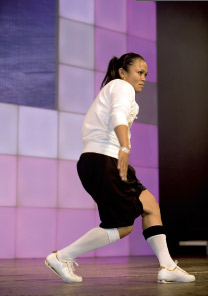
Even the folks at Nike admit that when they branched out into dance around three years ago, it was a pretty steep learning curve. While running, football and other mainstream sports are pretty easy to tap into, the underground world of dance has a whole heap of customs, clubs and competitors unknown to outsiders.
Break dancing emerged in New York in the mid-70s and became the dance of a burgeoning hip hop culture. From backstreets and basements, urban dance has now reached the masses, with women packing out workshops to learn some MTV moves. The style is loose and layered, the music is hip hop and the fancy footwork is carried out with finesse. This is not your average Saturday night fare: no smiling, sweating or singing along allowed. Though in addition to the appeal of the style, art and attitude that go along with dance, it is also a pretty handy calorie-burner. An hour of dance can burn up to 400 calories – more than surfing, aerobics or kayaking, don’t you know.
But the scene still remains largely underground, making it difficult to dig out dance talent. Events such as the Nike Dance Clash seek to change that by drawing deft dancers
out of their studios and on to the stage to battle over who’s got the best moves. So far, the comps have helped dancers evolve from unknowns into top athletes, and some have
taken part in TV ads, Nike campaigns and even worked with stars like Madonna, if that happened to be their thing. We caught up with Parisian dancer Clara Bajado – the latest
winner of Nike Dance Clash.
How long have you been dancing?
My father was a renowned ballroom dancer in the Philippines and when I was younger we used to watch dancing videos together. When I was eight, my mum wanted me to take ballet classes but I thought it wasn’t cool enough, so I opted for modern jazz. Then at 16, a friend at school took me to a hip hop class and I instantly loved it. I took endless classes and workshops to improve my skills in old school, such as lock, pop and bboy, and new school hip hop moves. Then a year later I discovered house dance.
What were you doing before the dance Clash?
I spent three months in New York in 2000 doing really intensive house and hip hop workshops. Then in 2006, my friends encouraged me to come to London and teach, so I took up a post at Pineapple dance studio. That job was a good way to promote house dance in the UK.
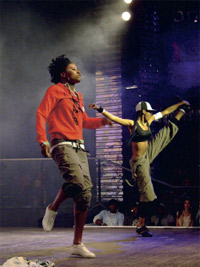
How did you hear about the event?
I actually missed the initial auditions, but a friend told me Nike had added an extra audition day. I only found out an hour beforehand, so just threw on my clothes, headed down there and managed to secure one of the last spots. From my first audition to the final, I was back of the queue and had the last number every time.
Were you nervous?
Everything moved so fast I only realised how much pressure was on in the final. I just kept getting through the rounds and being called back on stage. By the end, there were so few people that the rounds were moving really quickly and I had less time to recover between rounds. I knew over 300 girls had signed up, so I just intended to enjoy the competition and do my best, but by the time I made it to the final all my friends were cheering for me and I felt a real sense of responsibility to do well.
How did you prepare?
The Dance Clash is a freestyle comp so you have to improvise. You can’t prepare a routine beforehand, as you don’t even know what the music will be. It’s perfect for me, as even when I devise a routine, the chances are the next day I won’t remember it. Once the music is on, you literally have seconds to get the beat and formulate some steps, so it’s pretty difficult.
How important is the music?
When you get on stage, you just have to move, you don’t think about it too much, you just feel it and go with it and the moves come naturally. The style of music changes in every contest, so you need to have good improvisation skills and creativity. If I’m going to a hip hop or house dance contest, I never listen to that type of music before I go, so that I don’t get used to it. It’s good to be surprised by the music – it makes you listen to it more closely.
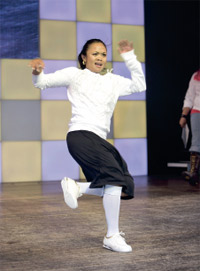
How did it feel when you won?
When they said my name, I was stunned. It wasn’t until I saw my friends going crazy in the audience that it really sunk in that I had won. I never entered with winning in mind, I just wanted the opportunity to get up there and take part in a big dance event.
How often do you train?
I used to train every day, but now I only dance when I really feel like I want to. If I force myself to practise every day, I run out of creativity.
Where do you get your inspiration from?
From everything! From people I meet, from my origins, from stuff I see in the street. With freestyle, you get inspired by the music and the atmosphere as you dance so you’ll always be surprised by what you’ve done. Even when I saw footage of the Nike Dance Clash, I didn’t remember some of the moves I did. As a freestyler, you can pull out the greatest move of your life in a club but then not be able to replicate it in a show. On the flipside, I do have some signature moves that I fall back on when I’m tired or have run out of ideas and I always know they’re going to work.
Does dancing in front of a crowd make a difference?
It helps your motivation massively. If I ever feel like I can’t go on and that I have no more energy, when I step on stage, my battery is instantly recharged and the crowd spurs me on to perform. you are engaged in a battle to be the best dancer and want to win over the crowd, but afterwards there is no rivalry behind the scenes. There’s a lot of mutual respect for each other.
Watch the footage of the Dance Clash final here!
Words: Amy Lindsay
Watching the Nike Dance Clash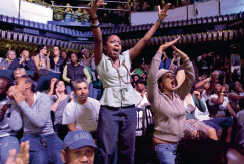
The Nike Dance Clash does exactly what it says on the tin, or should that be flyer. It’s a fight to the death between the best female dancers in the country and they’re battling for their entire careers. I’ve seen my fair share of ‘dance off’ scenes in the last few years, courtesy of various teen movies, but this is an entirely different affair. The atmosphere is intense and it is clear from the anticipation of the crowd that this is a big deal. The venue is dark, the people are cool, the music is hip hop, and it’s loud, very loud.
The dancers are split into groups and shown to the stage. at first it’s survival of the fittest as the dancers tussle to stand out of the 10-15-strong pack of girls, each body popping and breaking to exceptionally high standards. As the group gets smaller certain dancers begin to shine. With more room and more attention, the girls thrive in the spotlight and the crowd begin to pick their favourites. When it’s finally down to the last four girls, the battle really begins. Imagine the MTV base version of 8 Mile, with more lights, a bigger crowd and 10k up for grabs, and you may get the feel for the sheer size of the event.
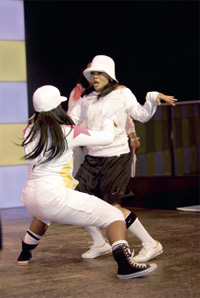
Until now every dancer has just been a number, but as the completion runs on, those with the true ability and individuality begin to stand out. From this point on it’s Clara Bajado all the way. She’s tiny and wearing a hat that totally covers her face, but when she body pops rings around her opponent, her stature is of little consequence. The crowd cheer and whistle with the endless surprises that Bajado brings to defeat the other dancers and the excitement is hard to handle, at times strangely unbearable. Her style is so street and smooth that, as talented as her opponent is, Bajado had basically moon-walked her way out of the building with the title 10 minutes before the end of the show. After conquering every dancer left standing, Bajado is crowned number one, and the crowd is ecstatic.
Three thoughts pass through my mind as I leave the show. How can I get tickets to the next clash? Where is the nearest dance floor? And, God help the next person that faces Bajado!
Watch the footage of the Dance Clash final here!
Words: Tiffany Hearn

